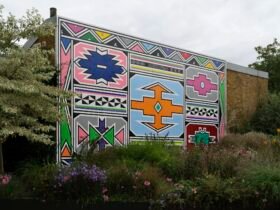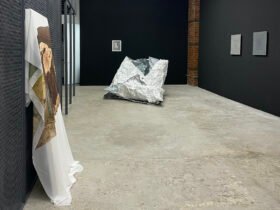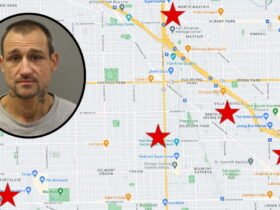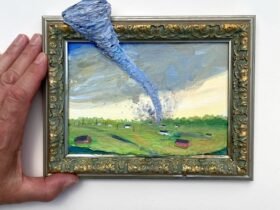On October 7, 2023, I had plans to meet my good friend, Palestinian fashion designer Suzy Tamimi, at the Brooklyn Museum and view the groundbreaking exhibition African fashion. Despite the enormous emotions that overwhelmed us with the news that morning Suzy and I chose to be together and continue with our plans to meet at the museum. I had just started my research fellowship at the Metropolitan Museum of Art’s Antonio Ratti Textile Center, and had a keen interest in learning about the ways in which traditional fashion on the African continent should be exhibited alongside contemporary styles – an approach to exhibiting of Palestinian clothing that I haven’t seen yet.
No one else was better suited to join me than Suzy, a creative force who… Freedom fighter collection 2019repurposing of the sixties tatreez fragments made in Palestinian refugee camps on camouflage fabric, boxing robes and sporty casual clothes. Together with the embroidery of Palestinian women, she establishes the weapons and armor of resistance, and a duality of strength and femininity. Reclaiming the long-stigmatized title of “freedom fighter” as an honorary title reveals an ancestral power that the Palestinian spirit needs in times of danger, and presents a fascinating and poetic paradox. African fashion began with the end of colonial rule on the continent and showcased the fruits of the independence movements that liberated some 48 countries by the late 1960s and led to a cultural renaissance that drew on local traditions to create new and innovative fashion . This new imagery expressed a renewed political hope in the wake of colonial liberation, an ambition also harbored by Palestinians living under Israeli military occupation and by those of us living in exile.
Arriving a little early at the Brooklyn Museum, I sat outside the entrance, quiet and alone with my thoughts, and felt the light misty rain fall on my skin and frizzy hair. Amid the thunderous sounds of traffic in Brooklyn, an unusually thick fog obscured New York’s beautiful cityscape. After some time I saw Suzy on the horizon. The mist and clouds were different shades of gray and hung so low in the sky that they seemed to follow her path as she walked along. At that time, I did not yet know what the future held for us Palestinians, nor for my friends and colleagues in Gaza. Who can imagine the horror that would soon appear on our phones, every morning and night, for more than a year, without end? The world’s indifference and passivity towards Palestinian suffering, a betrayal. What I did know as a Palestinian in the diaspora was that freedom would one day come to us – although I could not have imagined that it would come at such a terrible and tragic cost to humanity.
Suzy and I allowed ourselves to be distracted from the day’s events, getting lost in the dazzling garments presented in African fashion. Then we wandered aimlessly through the galleries, sharing what we could of our dismay against a backdrop of great masterpieces, which were now just a gray blur in my mind. Perhaps it was the same gray mist and clouds that hung heavy outside, now fixed on my shoulders, weighted down and with no end in sight.
We arrived at the Arts of the Islamic World collection gallery, and to our surprise, we were met by an exhibition including a traditional Palestinian dress, or thobe in Arabic. The thobe was colorfully criss-crossed with traditional Gaza motifs along the skirt, sleeves and chest, including patterns of amulets, zigzags and cypresses, each of which had a protective quality for the wearer that warded off the evil eye. The stitching consisted mainly of bright red and pink silk threads, decorated with handmade purple and white lace that reflects the specialized skills of the maker and the festive occasion for which she must have prepared this garment. The women of Gaza and their beloved vibrant decorations, including the wealth of hand-woven Syrian Atlas silk in the shoulder panels, were on full display here in a museum in my own Brooklyn, New York. I felt such immense pride that the only thobe I saw permanently was in the town and district where my son was born.


However, the label on the wall indicated that the thobe was merely a ‘black robe’ from ‘circa 1930-58’ in ‘Palestine/Israel’, without any specific geographical, social or cultural details that could help the visitor understand the process of make to understand. the dress, or the life of the woman to whom it belongs. ‘Israel’ was crossed out in red pen. I could tell that the wall label had been written by a well-meaning employee, doing their best to understand the treasure before them – perhaps taking into account an obscure archival document that gave them no clues as to its origins. As a Palestinian clothing historian who studied under my mother’s guidance, Feryal Abbasi-Ghnaimand worked with prominent elders in the field throughout my career, I knew immediately that the thobe came from the historic Gaza region, perhaps created in the early 20th century. The power of the dress is that it, the thobe, can undermine attempts to suppress Palestinian voices through its materials, motifs and execution. She tells many stories in one.
At that moment, Suzy and I looked straight at each other, eyes wide, at first with a mutual sense of urgency that the thobe – our thobe – was the only thread or shred of representation we had in the museum. Then we softened, because we knew what awaited us: a fight against repression and for representation, a recurring cycle to which we have been accustomed since childhood. Whether during the Federal Bureau of Investigation’s intensive surveillance of Arab and Muslim communities in the 1990s, after the September 11 attacks on the World Trade Center, or during every Israeli bombing of occupied Palestine, Lebanon or Syria over the years , it was always the same. . Palestinian voices are drowned out in the political and social strife of the dominant discourse in the United States, our humanity is reduced to debates about Fox News And MSNBC. Year after year we are still here.

The gray clouds are much heavier for the Palestinians who were spared the death and destruction of Gaza and no longer know the same world. The psychological trauma of witnessing friends, family and colleagues fighting for their lives from behind a phone screen, burning alive as they receive a message IV driphas caused my total dissociation from the world around me. At the beginning of the genocide, I looked around at the world as a place I once belonged had become unrecognizable, inhospitable, and depraved. To the rest of the world, Palestinian life seems to be nothing more than numbers of deaths. Now I can’t even look up, let alone look around.
If I look up, I’m probably doing it during my thobe research, which found a clue as to who the women who made, are or were are. Just as we are nameless and placeless in the news, our traditional thobes live in similar inhumanity in the United States without any information about who made the dress and where it is now. Sometimes I will find a little piece of information about the thobe through its construction. She was superstitious when she embroidered a blue bead in her tatreez for good luck; she wore a belt if it is made of cloth faded, except for the space under the chest panel which was protected from the sun. This information may seem minuscule and insignificant, but it brings me closer to the creator and bearer (often the same person) and helps me reconstruct the life she once lived and who she once was.

We don’t often see the Palestinian image reflected in a comprehensive and humane way in museum spaces, and we certainly don’t see our traditional clothing on display unless it is used to portray us as terrorists or static biblical characters. Palestinians are rarely mentioned as a cultural or ethnic group North American and European museumswho tend to opt for more obscure geographical attributions such as ‘Ottoman Syria’, ‘Bedouin’ or ‘the Holy Land’. Researching Palestinian history in the ancient world is an even more difficult task, requiring specific knowledge of the naming conventions of earlier kingdoms and the years of rule by various empires over time. Regardless of these realities, and in spite of them, I know how to navigate museum spaces, and find that the curators and staff are often nice people who have inherited a flawed, colonialist institution that has somehow remained in the past stiches. So with everything I could muster, I decided to raise my voice to anyone at the Brooklyn Museum who would listen.
Fortunately, I found the Brooklyn Museum incredibly responsive to my request for a discussion. Kat McFarlin, my generous colleague at the Metropolitan Museum of Art and coincidentally one of the original installers of the thobe, introduced me to Joan Cummins, curator of Asian art at the Brooklyn Museum, on October 19, 2023. Cummins immediately accepted my offer to include the Palestinian dresses in the collection and rewrite the label for the Gaza thobe on display. After my conversations with the curatorial staff to coordinate the visit, I spent the day viewing the 35 Palestinian dresses in the museum’s collection, helping them identify the dresses geographically and ensuring that they were properly archived.


On May 15, 2024 – the 76th annual commemoration of al-Nakba or النكبة — Suzy and I visited the Brooklyn Museum again. This time it was with renewed hope: the wall label I had voluntarily written was approved by the curators and installed in April. The thobe I had encountered that foggy Saturday morning is now rightly attributed to ‘Palestine (Gaza Region)’, a testament to Palestinian belonging to be read by a world I can no longer recognize, and which I sincerely feel I feel like I no longer belong there. belong. I still don’t often bother to look up from the dresses I study, and when I do, it’s either to see the smile of my beautiful son or the joy of my wonderful people. I know not how long these gray clouds will press upon me; they now feel as impossibly heavy as the rubble of collapsed buildings that buried us alive.
This Gaza thobe was made and worn by someone I am in a relationship with; she was my eldest. And honestly, Americans should learn about Palestinian identity, art and culture if they want to embrace opinions about whether we deserve life or death. The thobe is a testament to Palestinian belonging – my property – in this world, even if it was so deeply undeserved to us. I will continue the fight to showcase Palestinian beauty, clothing and artistry everywhere I go.













Leave a Reply